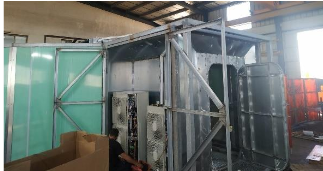Amadee-20-MARSLOCK
Details
| Acronym | MarsLock |
| Description | This study will investigate if the airlock or its sub-components can serve as a prototype of an airlock for Mars |
| Principal Investigator (PI) | Dr.-Ing. Christiane Heinicke | christiane.heinicke@zarm.uni-bremen.de |
| Organisation | University of Bremen, ZARM -Center of Applied Space Technology and Microgravity |
| Co-Investigators | Prof. Dr. Johannes Schöning University of Bremen, Human-Computer Interaction Bibliothekstraße 5, 28359 Bremen, Germany email: johannes.schoening@uni-bremen.de, phone: +49-421-218-63590 |
Summary

Airlocks are arguably the most critical component of a Mars habitat: They allow the crew to enter and leave their habitat and venture into the Martian environment. Practically all simulation habitats in operational environments therefore feature a room that serves as a simulated airlock. However, most spaceflight simulation bases have only simulated airlocks. In these, the airlock is under ambient pressure and “locking” is simulated simply by having the crew wait for a specified amount of time. Decontamination of suits that would be needed on Mars both during inbound and outbound passage crew is ignored more often than not. Hence, most information available on simulation EVAs is thwarted by the unrealistic setup of and operations inside the airlock. Given the set-up of the D-MARS station, with the slight over-pressurization of the habitat and inherently necessary dust mitigation, the station’s airlock is deemed to be more realistic than average; therefore, this study will investigate if the airlock or its sub-components can serve as a prototype of an airlock for Mars. During A-20, information on the usability of anexisting, (somewhat) realistic airlock, and lessons for the design of future airlocks for extraterrestrial (and simulated) environments shall be obtained. Crew feedback will be collected via questionnaires to be answered by the crew after each EVA and post-mission. Airlock usage and adherence to airlock protocols will be monitored by cameras in-and outside the airlock. The experiment will also evaluate the effectiveness of simple dustmitigation activities and aim to understand how routine affects the adherence to dust mitigation protocols. Effectiveness of dust mitigation will be quantified by mass measurements of imported dust/sand (after routine sweeping).
Experiment Data
| Date | Files |
|---|---|
| 2021-10-05 | screenshots with camera settings |
| 2021-10-09 | 1 sample movie, 1 screenshot |
| 2021-10-11 | 6 documents |
| 2021-10-18 | 6 word files, 1 picture |
| 2021-10-24 | 10 word files |
| 2021-10-30 | 6 word files, storage tracking |